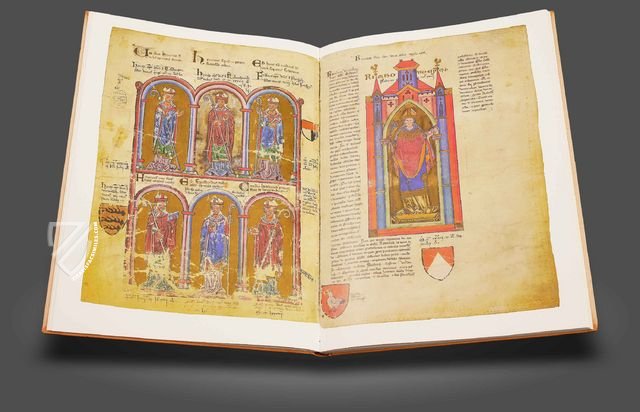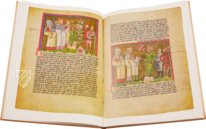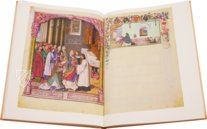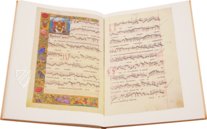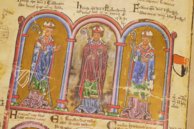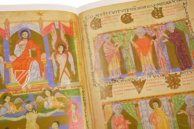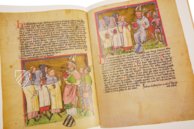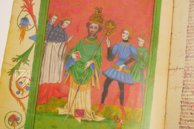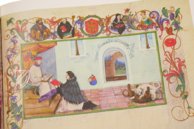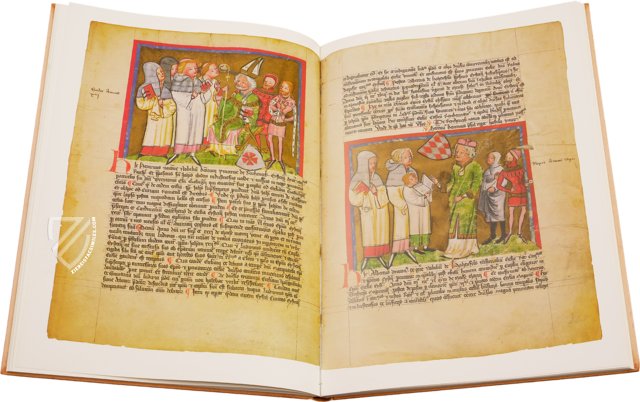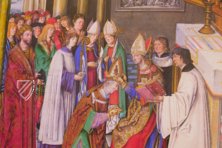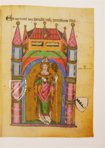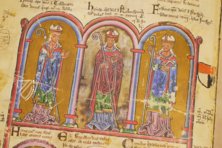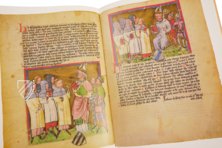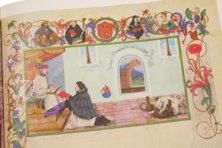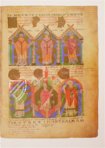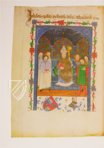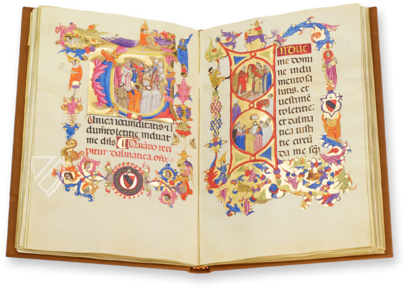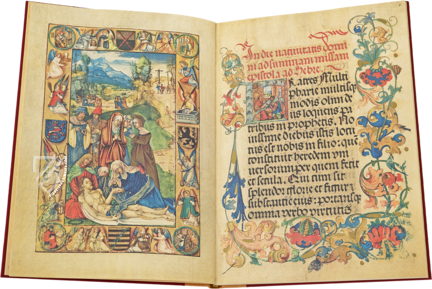Pontifical Gundekarianum
(1,000€ - 3,000€)
Created in 1071 at the behest of Bishop Gundekar II of Eichstätt as a pontifical, the Gundekarianum was used by the bishops of Eichstätt until 1697 and was continuously updated in the manner of a family genealogy. It is the most comprehensive medieval manuscript of its kind and is also a precious source for liturgical and art history. The original part of the manuscript contains a series of miniatures depicting Christ, twelve saints associated with Eichstätt, and all eighteen bishops of Eichstätt since the founding of the diocese by Willibald including Gundekar himself. More than a century later, Bishop Otto appended the register up to his own reign and thus set a pattern for his successors. Beginning ca. 1300, the short texts were replaced by long vitae and individual portraits replaced connected groups of bishops. The last miniatures were added in 1517, numbering 29 in total. They demonstrate the evolution of the art of illumination across four and a half centuries, making the manuscript not only an important record of the bishops of Eichstätt but an excellent source for the study of art history.
The Bishop of Eichstätt Gundekar II.
Gundekar II - also called Gunzo - was bishop of Eichstätt from 1057 to 1075. Although he was never officially beatified, he was venerated as such after his death. There are no reliable sources about the lineage from which he came. Due to his relationship to Archbishop Siegfried I of Mainz (1060-84), it can be assumed that Gundekar belonged to a noble family of the Middle Rhine. After his appointment as court chaplain by Queen Agnes, he left Eichstätt in 1045. Because of his membership in the royal family, he was able to maintain contact with the other court chaplains. At the instigation of the empress, Gundekar was designated bishop of Eichstätt on August 20, and his episcopal consecration followed on December 27 of the same year. In his bishopric he concentrated on his spiritual work, the mediation of salvation as his exclusive goal. To this end, he consolidated the network of parish organizations and built churches. In total, Gundekar's pontificate recorded 126 church consecrations, 101 within his own diocese. This extensive expansion of parishes was made possible by the Eigenkirchen system, i.e. by the respective landlords supporting the construction on their private property. Only a few bishop-owned churches with the sole right of occupation by the bishop were built. The last decade of his life was marked by the Investiture Controversy, the fight for secular and spiritual power. Gundekar renounced any influence on imperial and church politics and managed to maintain a distinguished distance and neutrality.
In Eichstätt itself, Gundekar made it his task to rebuild the partially demolished cathedral and consecrated the restored basilica in 1060. After his death, he was buried in the St. John's Chapel of the cathedral, which he had built in 1062. Today, the bishop's remains are in the Gundekar Chapel, a Gothic successor building.
The liturgy as the center
In 1072, the bishop gave to his cathedral church, the so-called Gundekarianum: a magnificently decorated manuscript, which still represents the most precious book possession of the Eichstätt cathedral chapter. It is an anthology of 257 leaves, 204 of which date back to the time of Gundekar. The core of the work is a 110-leaf pontifical, a compilation of the sacraments, ordinations and blessings to be administered by the bishop (the pontifex). The Eichstätt text follows a special type of pontifical books which were developed in southern Germany in the 10th and 11th centuries.
The pontifical is followed by a calendar, which is followed by a rituale, a compilation of blessings and prayers of the diocese from the Salian period. With this work, the performance of the liturgy became the focus of Gundekar's endeavors. It also shows that he was a supporter of the reform of the church, for it had a special emphasis on the valid communication of sacramental salvation. Gundekar saw in the sacraments the signs of salvation ordained by Christ, in which the salvation of redemption must continue and be realized in the individual. In addition to the liturgical texts, Gundekar's codex is also distinguished by its historical entries. Gundekar's successors added to these entries until 1697 with a total of 19 bound-in continuations with the bishop's vites and bishop's pictures in miniature painting. The valuable original is now kept in the Eichstätt Diocesan Archives.
Artistical decoration
The Pontifical Gundekarianum is richly decorated with artistic ornaments. In addition to simple, colorfully decorated initials, a large double "initial" is adorned, which presents the full name of the founder in an artistic entanglement. This is followed by a large initial expanded with leafy vines as well as one with an imaginatively painted border. The highlight of the pictorial decoration are the 29 full-page miniatures: In addition to plants and animals, 52 bishops of Eichstätt are portrayed in a unique opulence. The depictions also try to illustrate historical processes retrospectively to the founding phase of the bishopric in the 8th century.
Codicology
- Alternative Titles
- Liber pontificalis Eichstetensis
- Size / Format
- 84 pages / 46.0 × 37.0 cm
- Origin
- Germany
- Date
- 1071–1517
- Genre
- Language
- Illustrations
- 29 magnificent miniatures from different periods and countless gold-decorated initials, initial, majuscules and borders
- Patron
- Bishop Gundekar II.
Pontifical Gundekarianum
Gundekar II, Bishop of Eichstätt
The namesake of this manuscript, Gundekar II (1019–75), is believed to have commissioned it in 1071 before presenting it to Eichstätt Cathedral in 1072. As Bishop of Eichstätt, he was a supporter of church reform and appears to be a modest person because he did not order a full-page dedication miniature of himself. Instead, he merely appears alongside the other 17 bishops of Eichstätt in a classically styled architectural frame dressed in liturgical robes and holding a book and bishop’s staff.

Pontifical Gundekarianum
Johann von Eych, Prince-Bishop of Eichstätt
The work begun by Bishop Gundekar II was carried on by his successors until 1697, and thus one can witness an evolution of artistic styles beginning with the Romanesque and ending with the Renaissance. This splendid full-page miniature in the Northern Renaissance style still exhibits the elaborate ornamentation of the Gothic style in combination with new innovations for depicting human figures.
Johann von Eych (d. 1464) was also Archbishop-Elector of Mainz, Prince-Bishop of Augsburg, and eventually became a cardinal, although he never received his cardinal’s cap. His handsome portrait depicts the reformer enthroned as a powerful Prince of the Church and his entourage of both clerics and laymen indicates his spiritual and temporal authority.
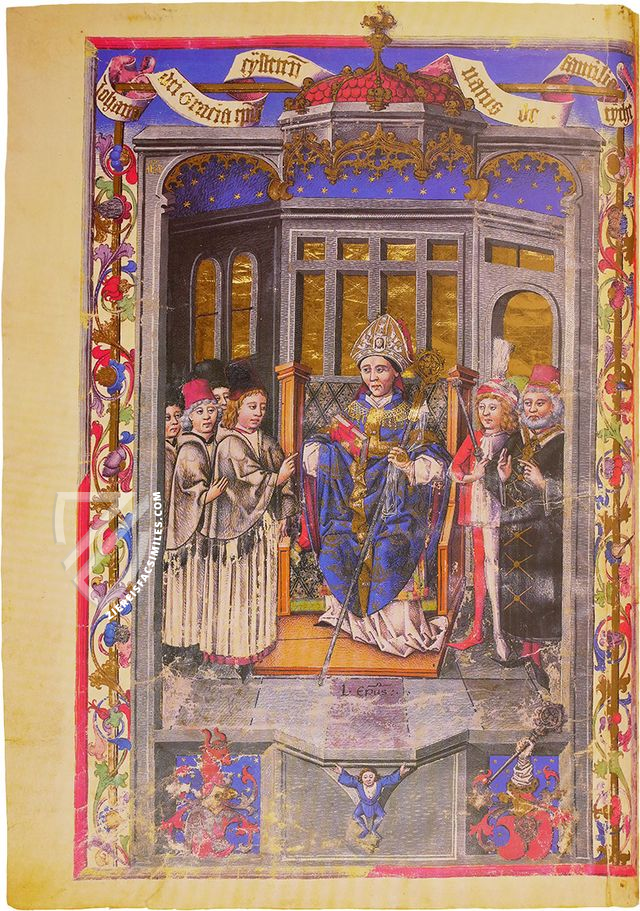
#1 Pontifikale Gundekarianum
Language: German
(1,000€ - 3,000€)
- Treatises / Secular Books
- Apocalypses / Beatus
- Astronomy / Astrology
- Bestiaries
- Bibles / Gospels
- Chronicles / History / Law
- Geography / Maps
- Saints' Lives
- Islam / Oriental
- Judaism / Hebrew
- Single Leaf Collections
- Leonardo da Vinci
- Literature / Poetry
- Liturgical Manuscripts
- Medicine / Botany / Alchemy
- Music
- Mythology / Prophecies
- Psalters
- Other Religious Books
- Games / Hunting
- Private Devotion Books
- Other Genres
- Afghanistan
- Armenia
- Austria
- Belgium
- Belize
- Bosnia and Herzegovina
- China
- Colombia
- Costa Rica
- Croatia
- Cyprus
- Czech Republic
- Denmark
- Egypt
- El Salvador
- Ethiopia
- France
- Germany
- Greece
- Guatemala
- Honduras
- Hungary
- India
- Iran
- Iraq
- Israel
- Italy
- Japan
- Jordan
- Kazakhstan
- Kyrgyzstan
- Lebanon
- Liechtenstein
- Luxembourg
- Mexico
- Morocco
- Netherlands
- Palestine
- Panama
- Peru
- Poland
- Portugal
- Romania
- Russia
- Serbia
- Spain
- Sri Lanka
- Sweden
- Switzerland
- Syria
- Tajikistan
- Turkey
- Turkmenistan
- Ukraine
- United Kingdom
- United States
- Uzbekistan
- Vatican City
- A. Oosthoek, van Holkema & Warendorf
- Aboca Museum
- Ajuntament de Valencia
- Akademie Verlag
- Akademische Druck- u. Verlagsanstalt (ADEVA)
- Aldo Ausilio Editore - Bottega d’Erasmo
- Alecto Historical Editions
- Alkuin Verlag
- Almqvist & Wiksell
- Amilcare Pizzi
- Andreas & Andreas Verlagsbuchhandlung
- Archa 90
- Archiv Verlag
- Archivi Edizioni
- Arnold Verlag
- ARS
- Ars Magna
- ArtCodex
- AyN Ediciones
- Azimuth Editions
- Badenia Verlag
- Bärenreiter-Verlag
- Belser Verlag
- Belser Verlag / WK Wertkontor
- Benziger Verlag
- Bernardinum Wydawnictwo
- BiblioGemma
- Biblioteca Apostolica Vaticana (Vaticanstadt, Vaticanstadt)
- Bibliotheca Palatina Faksimile Verlag
- Bibliotheca Rara
- Boydell & Brewer
- Bramante Edizioni
- Bredius Genootschap
- Brepols Publishers
- British Library
- C. Weckesser
- Caixa Catalunya
- Canesi
- CAPSA, Ars Scriptoria
- Caratzas Brothers, Publishers
- Carus Verlag
- Casamassima Libri
- Centrum Cartographie Verlag GmbH
- Chavane Verlag
- Christian Brandstätter Verlag
- Circulo Cientifico
- Club Bibliófilo Versol
- Club du Livre
- CM Editores
- Collegium Graphicum
- Collezione Apocrifa Da Vinci
- Comissão Nacional para as Comemorações dos Descobrimentos Portugueses
- Coron Verlag
- Corvina
- CTHS
- D. S. Brewer
- Damon
- De Agostini/UTET
- De Nederlandsche Boekhandel
- De Schutter
- Deuschle & Stemmle
- Deutscher Verlag für Kunstwissenschaft
- DIAMM
- Droz
- E. Schreiber Graphische Kunstanstalten
- Ediciones Boreal
- Ediciones Grial
- Ediclube
- Edições Inapa
- Edilan
- Editalia
- Edition Deuschle
- Edition Georg Popp
- Edition Leipzig
- Edition Libri Illustri
- Editiones Reales Sitios S. L.
- Éditions de l'Oiseau Lyre
- Editions Medicina Rara
- Editorial Casariego
- Editorial Mintzoa
- Editrice Antenore
- Editrice Velar
- Edizioni Edison
- Egeria, S.L.
- Eikon Editores
- Electa
- Emery Walker Limited
- Enciclopèdia Catalana
- Eos-Verlag
- Ephesus Publishing
- Ernst Battenberg
- Eugrammia Press
- Extraordinary Editions
- Fackelverlag
- Facsimila Art & Edition
- Facsimile Editions Ltd.
- Facsimilia Art & Edition Ebert KG
- Faksimile Verlag
- Feuermann Verlag
- Folger Shakespeare Library
- Franco Cosimo Panini Editore
- Friedrich Wittig Verlag
- Fundación Hullera Vasco-Leonesa
- G. Braziller
- Gabriele Mazzotta Editore
- Gebr. Mann Verlag
- Gesellschaft für graphische Industrie
- Getty Research Institute
- Giovanni Domenico de Rossi
- Giunti Editore
- Graffiti
- Grafica European Center of Fine Arts
- Guido Pressler
- Guillermo Blazquez
- Gustav Kiepenheuer
- H. N. Abrams
- Harrassowitz
- Harvard University Press
- Helikon
- Hendrickson Publishers
- Henning Oppermann
- Herder Verlag
- Hes & De Graaf Publishers
- Hoepli
- Holbein-Verlag
- Houghton Library
- Hugo Schmidt Verlag
- Idion Verlag
- Il Bulino, edizioni d'arte
- ILte
- Imago
- Insel Verlag
- Insel-Verlag Anton Kippenberger
- Instituto de Estudios Altoaragoneses
- Instituto Nacional de Antropología e Historia
- Istituto dell'Enciclopedia Italiana - Treccani
- Istituto Ellenico di Studi Bizantini e Postbizantini
- Istituto Geografico De Agostini
- Istituto Poligrafico e Zecca dello Stato
- Italarte Art Establishments
- Jan Thorbecke Verlag
- Johnson Reprint Corporation
- Josef Stocker
- Josef Stocker-Schmid
- Jugoslavija
- Karl W. Hiersemann
- Kasper Straube
- Kaydeda Ediciones
- Kindler Verlag / Coron Verlag
- Kodansha International Ltd.
- Konrad Kölbl Verlag
- Kurt Wolff Verlag
- La Liberia dello Stato
- La Linea Editrice
- La Meta Editore
- Lambert Schneider
- Landeskreditbank Baden-Württemberg
- Leo S. Olschki
- Les Incunables
- Liber Artis
- Library of Congress
- Libreria Musicale Italiana
- Lichtdruck
- Lito Immagine Editore
- Lumen Artis
- Lund Humphries
- M. Moleiro Editor
- Maison des Sciences de l'homme et de la société de Poitiers
- Manuscriptum
- Martinus Nijhoff
- Maruzen-Yushodo Co. Ltd.
- MASA
- Massada Publishers
- McGraw-Hill
- Metropolitan Museum of Art
- Militos
- Millennium Liber
- Müller & Schindler
- Nahar - Stavit
- Nahar and Steimatzky
- National Library of Wales
- Neri Pozza
- Nova Charta
- Oceanum Verlag
- Odeon
- Orbis Mediaevalis
- Orbis Pictus
- Österreichische Staatsdruckerei
- Oxford University Press
- Pageant Books
- Parzellers Buchverlag
- Patrimonio Ediciones
- Pattloch Verlag
- PIAF
- Pieper Verlag
- Plon-Nourrit et cie
- Poligrafiche Bolis
- Presses Universitaires de Strasbourg
- Prestel Verlag
- Princeton University Press
- Prisma Verlag
- Priuli & Verlucca, editori
- Pro Sport Verlag
- Propyläen Verlag
- Pytheas Books
- Quaternio Verlag Luzern
- Reales Sitios
- Recht-Verlag
- Reichert Verlag
- Reichsdruckerei
- Reprint Verlag
- Riehn & Reusch
- Roberto Vattori Editore
- Rosenkilde and Bagger
- Roxburghe Club
- Salerno Editrice
- Saltellus Press
- Sandoz
- Sarajevo Svjetlost
- Schöck ArtPrint Kft.
- Schulsinger Brothers
- Scolar Press
- Scrinium
- Scripta Maneant
- Scriptorium
- Shazar
- Siloé, arte y bibliofilia
- SISMEL - Edizioni del Galluzzo
- Sociedad Mexicana de Antropología
- Société des Bibliophiles & Iconophiles de Belgique
- Soncin Publishing
- Sorli Ediciones
- Stainer and Bell
- Studer
- Styria Verlag
- Sumptibus Pragopress
- Szegedi Tudomànyegyetem
- Taberna Libraria
- Tarshish Books
- Taschen
- Tempus Libri
- Testimonio Compañía Editorial
- Thames and Hudson
- The Clear Vue Publishing Partnership Limited
- The Facsimile Codex
- The Folio Society
- The Marquess of Normanby
- The Richard III and Yorkist History Trust
- Tip.Le.Co
- TouchArt
- TREC Publishing House
- TRI Publishing Co.
- Trident Editore
- Typis Regiae Officinae Polygraphicae
- Union Verlag Berlin
- Universidad de Granada
- University of California Press
- University of Chicago Press
- Urs Graf
- Vallecchi
- Van Wijnen
- VCH, Acta Humaniora
- VDI Verlag
- VEB Deutscher Verlag für Musik
- Verlag Anton Pustet / Andreas Verlag
- Verlag Bibliophile Drucke Josef Stocker
- Verlag der Münchner Drucke
- Verlag für Regionalgeschichte
- Verlag Styria
- Vicent Garcia Editores
- W. Turnowski Ltd.
- W. Turnowsky
- Waanders Printers
- Wiener Mechitharisten-Congregation (Wien, Österreich)
- Wissenschaftliche Buchgesellschaft
- Wissenschaftliche Verlagsgesellschaft
- Wydawnictwo Dolnoslaskie
- Xuntanza Editorial
- Zakład Narodowy
- Zollikofer AG

